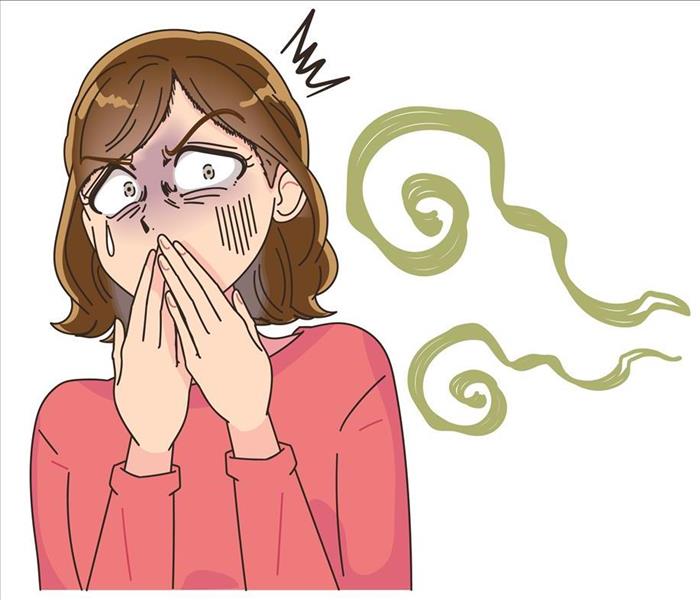What Makes Fire-Related Smells So Difficult to Eliminate?
7/10/2020 (Permalink)
 When fire damage happens, contact SERVPRO of Naples/Marco Island at (239) 302-5700. No matter how big or small the problem.
When fire damage happens, contact SERVPRO of Naples/Marco Island at (239) 302-5700. No matter how big or small the problem.
Fire-Related Smells in Your Naples Home Are Hard to Neutralize Partly Because Odorous Particles in Smoke Travel Everywhere and Penetrate Materials Deeply.
When materials burn in your Naples residence, a chemical reaction called “combustion” is taking place. This is the process by which solid materials, acted on by heat, are turned into gases. During the process, materials break down, and their components combine with oxygen to form new gaseous compounds. Since this reaction is not entirely efficient, not all solids convert to gas, and waste is left over. That results in smoke-filled with odorous solid particles and surface residues. Depending on the materials burned, these smell-producing substances are of varying degrees of difficulty to clean up. Different methods are usually required to effectively remove or neutralize each kind of odorous material.
How Do Smoke Particles Make Deodorization a Difficult Task?
Naples fire damage remediation companies like SERVPRO understand the process by which fire-related odors develop. They also know how the nature of smoke makes their job more of a challenge. The odorous particles in smoke go everywhere the smoke goes. That usually includes the highest reaches of your home and all of its most difficult-to-access areas. Some of the troublesome places smoke deposits smelly particles are:
HVAC system ducts
Attic rafters and insulation
Hidden and hard-to-reach sections of ceilings and walls
High fixtures
Irreplaceable possessions
The clouds of particulate matter generated by fires usually rise and coat HVAC ducts with a layer of soot. If not properly cleaned, your ventilation system circulates odorous particles throughout your home long after a fire has been remediated.
Smoke particles especially impact porous materials and make them extremely hard to clean. The heat of a fire opens up the pores of these materials around your residence, making it easier for smelly smoke particles to penetrate them deeply. Once the fire ends and the surrounding environment cools, the pores contract and trap the odorous substances inside. Afterward, the temperature never rises enough to let it all escape back out of the affected structural elements and contents. However, when it does get warm and humid, strong odors often reappear.
What Are the Different Types of Fire-Related Residues?
As your home burns, waste from the combustion process results in surface soot residues and airborne smoke particles. Smelly soot residues remain around the site where materials burn and smoke travels throughout your home, depositing odorous soot particles. In general, there are four primary types of residues:
Wet smoke
Dry smoke
Protein smoke
Fuel oil smoke
Each fire produces one or more of these waste products, depending on the type of materials burned, the amount of oxygen present, and the rate at which the fire burns. Protein and fuel oil smoke residues result solely from the materials burned, namely animal proteins and fuel oil. Wet smoke residues are created by slow-burning fires that are deprived of oxygen and consume synthetics. Conversely, dry smoke residues often develop due to oxygen-rich, fast-burning fires that consume natural materials.
What Are the Challenges of Cleaning Up Soot Residues?
In SERVPRO’s experience, each residue presents its unique challenges. Wet smoke residues tend to be the most difficult to clean up because of how they are created. These residues are formed by slow-burning fires that linger in an area for a long time, trap smoke near the heat source, and pick up more liquid components. Wet smoke residues, therefore, usually produce large, greasy/oily, easily smearable particles. Moreover, since the fire continues in one place for an extended time, its smelly products are more easily able to permeate materials thoroughly. Protein smoke residues are extremely odorous and can sometimes be invisible. They require a lot of work because, many times, your entire house needs to be fully cleaned to remove the smells of these residues.
Other fire wastes, like dry soot and fuel oil smoke residue, are much easier to remediate. Dry soot is often less odorous and comes in the form of small dry particles. These usually do not penetrate surfaces and are easily wiped away. Fuel oil residues mostly just present a problem when they are dry and crusty. If restoration technicians are not careful, they could scratch surfaces as they are wiping these residues away.
How Can SERVPRO Neutralize Fire-Related Odors?
SERVPRO technicians are experts at handling the unwanted smells of fire damage. Some of the methods and tools they employ to neutralize odors are:
Clearing ventilation ducts with HVAC cleaning systems
Using air scrubbers, ozone machines, and Vaportek units to deodorize interior air
Deodorizing and sealing structural elements, HVAC systems, and difficult-to-access areas with ultra-low volume (ULV) foggers
Treating carpets and upholstery with injection devices and deodorants
Cleaning up greasy residues with wet cleaning methods, using solutions like tri-sodium phosphate (TSP)
Using dry sponges to remove non-grease residues
Using these advanced tools and techniques, SERVPRO is often able to make your home smell like it never even experienced a fire.
If you ever need help handling fire damage, call SERVPRO of Naples/Marco Island at (239) 302-5700.






 24/7 Emergency Service
24/7 Emergency Service